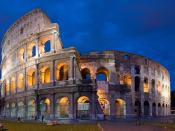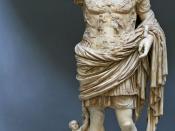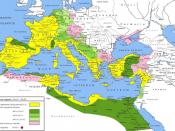The Roman Empire, founded by Augustus Caesar in 27 B.C. and lasting in Western
Europe for 500 years, reorganized for world politics and economics. Almost the entirety of the
civilized world became a single centralized state. In place of Greek democracy, piety, and
independence came Roman authoritarianism and practicality. Vast prosperity resulted. Europe and
the Mediterranean bloomed with trading cities ten times the size of their predecessors with public
amenities previously unheard of courts, theaters, circuses, and public baths. And these were now
large permanent masonry buildings as were the habitations, tall apartment houses covering whole
city blocks.
This architectural revolution brought about by the Romans required two innovations: the
invention of a new building method called concrete vaulting and the organization of labor and
capital on a large scale so that huge projects could be executed quickly after the plans of a single
master architect.
Roman concrete was a fluid mixture of lime and small stones poured into the hollow
centers of walls faced with brick or stone and over curved wooden molds, or forms, to span
spaces as vaults.
The Mediterranean is an active volcanic region, and a spongy, light, tightly
adhering stone called pozzolana was used to produce a concrete that was both light and extremely
strong.
The Romans had developed potsalana concrete about 100 B.C. but at first used it only for
terrace walls and foundations. It apparently was emperor Nero who first used the material
on a grand scale to rebuild a region of the city of Rome around his palace, the expansive Domus
Aurea, after the great fire of AD 64 which he said to have set. Here broad streets, regular blocks
of masonry apartment houses, and continuous colonnaded porticoes were erected according to a
single plan and partially at state expense. The...


